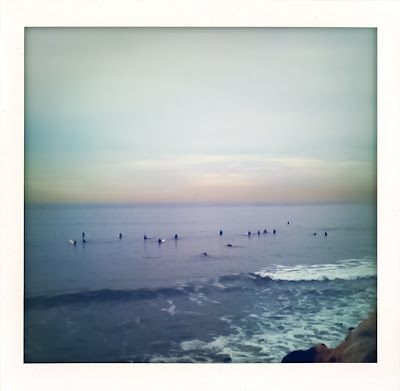
It’s 4:30 am, Sunday morning. September 19, and my surfing sensei, John-O, is singing loudly. I’m still shaking off a very good dream or visions of last night's lobster, courtesy of Arthur and Heidi - John-O's step-father and mother, respectively- and the singing is getting on my nerves. Alas, in one hour the sun will be up and swells from Hurricane Igor will be slamming the coast of New England. Waves make sensei very happy and when sensei happy, sensei sings.

We lash the boards to the roof of the rental car- a flagrant violation of the rental contract- and pull out of his family’s driveway at 5:10, headlights ablaze through winding back-roads under a canopy of huge maples, elms and oaks, flanked by ancient stone walls, bound for heavy water.
“Carrot?”, John-O sings, “apple?”. A mad look in his eyes lets me know he’s already surfing something somewhere as cedar shake homes rip past in the dark.

I wave off the fruit and veggies. Visions of Dunkin’ Donuts’ coffee and glazed crullers drift through my mind. It’s too damn early for carrots. The day before, we had taken a leisurely, midday jaunt in his stepfather Arthur’s gorgeous 28 foot Fortier boat, the “Lagniappe” (which aptly means, “something given or obtained gratuitously or by way of good measure”).

"Sensei" John-O loads the Lagniappe.
We trolled the local islands and cobble channels for striped bass and bluefish, all the while keeping our eyes peeled for distant breakers where, under normal conditions, none would appear, seeking indicators of Igor’s arrival. An hour into our fishing trip, we pulled up outside a narrow channel breaking left and right heavy enough to give local boatmen pause to reconsider. John-O's eyes rolled back in his head. Arthur gamely hung outside, eating his sandwich and downing a beer while John-O made easy work of the solid left ripping through the channel on his quad fish. I managed to drop into a few myself before getting dragged into the impact zone and spanked. I then managed to burn off all remaining pride clawing my way back to Arthur and the good fortune of Lagniappe.

Off an island not near you, John-O spots breakers in the channel...

...and makes for the water.
But today was a different deal. We hit the first break by 6 a.m., the parking lot alive with the sound of boards being waxed and wetsuits being zipped. Along the bluff the silhouettes of surfers in hoodies stare out at the incoming swell as the line-up is calculated, the paddle out assessed. Igor is pounding the bluff with 6-10 foot sets wrapping around the point from the south. It’s a very impressive sight anywhere, but here in New England, it’s a downright revelation.

Solid sets- 6-10 feet- wrap around the local lighthouse. 6 am.

Local bears, stirred from slumbers, prep for the paddle out.

We’re back in the car, in search of more and less at the same time- more breaks, less people. This pattern continues over the next few days, as Igor jacks up, registering at some breaks like small houses12- 15 feet high, or weighing in lean and mean at others, 6-8 feet and breaking fast. At these more intimidating spots, I feel my manhood retreat, leave my board on the car, pull out my camera and stare like the rest of the civilians. Standing on the lawns of families not yet stirring or in front of working class Irish pubs still sleeping off the night before, I bust out my Nikon D700 with a very old 200mm zoom and even older 2x converter and take a whack at documenting this southeast swell and these unheralded breaks (that shall remain, for want of staying alive, nameless).

Too big and too fast, but otherwise perfect. 8-10 foot sets, steady offshore winds, lefts and rights for days.

Unknown local at an undisclosed break makes the drop into a very fast 10' barrel.

John Wingate- Dropping in.


Geo Quiz: The ferry is going where?

7 am. A local surveys the lineup.

Casual under pressure, a local tucks in.

Up...
..but not over.


The working class before clocking in.


8 am. Sunday. The Dawn Patrol Checks Out.

In a crowded parking lot, seasoned local shows up California style...

...Inside and out. On Monday, that same local was spotted ripping into several overhead lefts and rights.

A fast right past the rocks, somewhere below the mansions of Newport.
Monday, September 20th, our last day. Tomorrow, we'll be back in Southern California, to a very flat sea. After a surfing and shooting a stellar dawn session 40 minutes to the south, we stand on the bluffs of this remote Rhode Island rivermouth, and watch it all go off, big, chunky and steady. 12-15 foots sets pound the rocky shore all day long while the winds blow strong offshore, holding all but the strongest paddlers off the wave. The two riders below had the joint wired, and dropped into most of the heaviest bombs.
Goodbye New England, local style:






































































